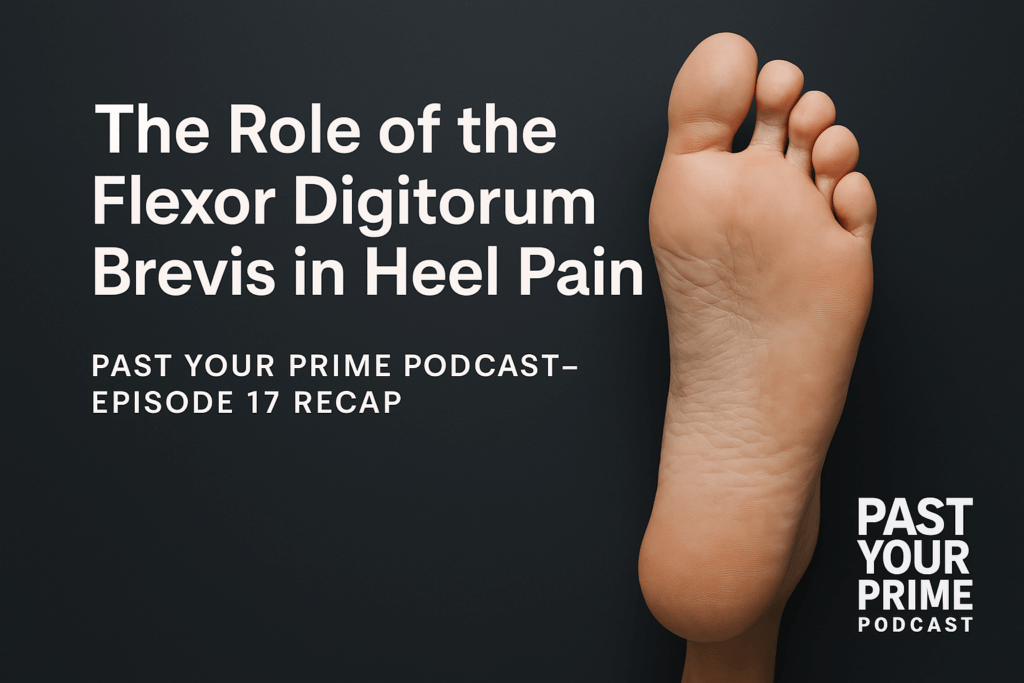Past Your Prime Podcast – Episode 17 Recap
Ever been told you have plantar fasciitis—but nothing seems to work?
If you’ve been dealing with flexor digitorum brevis heel pain, there’s a good chance you’ve been misdiagnosed. The symptoms can feel almost identical—until you know what signs to look for.
You’ve iced it. Stretched it. Rolled it. Maybe even dropped hundreds on orthotics.
Still hurts—especially when you get out of bed or push off during a workout.
It might not be your plantar fascia at all.
In Episode 17 of the Past Your Prime podcast, Craig and Alex unpack a commonly missed source of heel pain: the flexor digitorum brevis (FDB) muscle. It’s frequently overlooked, mistreated, and misunderstood—especially in active adults and aging athletes trying to stay in the game.
✅ What You’ll Learn in This Episode:
- Why FDB heel pain is so commonly mistaken for plantar fasciitis
- The four diagnostic pillars Craig uses to confirm the real source (structural, functional, treatment response, and trigger management)
- How to induce a cramp to confirm the diagnosis (and when not to)
- Key signs to identify an FDB problem in real time
- Treatment strategies including:
- Modified Low-Dye taping to reduce midstance load
- Soft tissue massage and cross-friction at the muscle belly and origin
- Muscle activation of synergists and antagonists (posterior tibialis, anterior tibialis, toe extensors)
- Why midstance is the most important phase of gait in FDB-related heel pain
- How to manage triggers and build a sustainable treatment plan—especially if you’re trying to return to activity

What Is the Flexor Digitorum Brevis?
The flexor digitorum brevis is a small, powerful muscle located on the bottom of your foot. It runs from the heel (calcaneus) and branches out toward the toes. Its job? To help flex the toes and stabilize the arch—especially during walking, running, and loading midstance.
Unlike the plantar fascia, which is a thick band of connective tissue, the FDB is a muscle, meaning it can cramp, fatigue, become overloaded, and respond to targeted activation or release work.
Why FDB Heel Pain Gets Missed
FDB pain is frequently misdiagnosed as plantar fasciitis—and here’s why:
- Both cause pain at or near the heel
- Both flare up during weight-bearing activities
- Both can worsen in the morning or after prolonged rest
Listen to episode 16 if you want a deep dive on how to differentiate the two injuries.
But FDB symptoms often have a muscle-specific signature that plantar fascia injuries don’t:
- Cramping during gait
- Pain during midstance or toe-off
- Sensitivity in the muscle belly or origin—not just the heel itself
When to Suspect Flexor Digitorum Brevis Heel Pain
Here are five signs your heel pain might be coming from the FDB—not your fascia:
- Cramping in the arch or bottom of the foot during or after walking
- Pain triggered during midstance rather than just heel strike
- Manual pressure on the muscle belly reproduces pain or discomfort
- Soft tissue work or taping directly improves symptoms
- Stretching the fascia doesn’t help—or makes it worse
Treatment Tips for FDB-Related Heel Pain
In the episode, Craig breaks down a simple, effective treatment plan:
- Modified Low-Dye Taping: Unloads the arch during gait
- Manual Therapy: Soft tissue massage or cross-friction to the FDB origin
- Muscle Activation:
- Posterior Tibialis for arch control
- Anterior Tibialis and toe extensors for balance
- Balance Training: Incorporate barefoot standing drills and slow midfoot loading
- Shoe Audit: Consider reducing aggressive arch supports that inhibit foot function

“If it always feels like plantar fasciitis—but nothing helps—it’s time to stop chasing the fascia and start testing the muscle.”
🎧 Listen to Episode 17:
🗣️ Want Us to Review Your Case?
Comment on YouTube or ASK A QUESTION to be featured in an upcoming episode of the Comments Section.
Stay Connected:
Follow us on Instagram:
Craig Smith | Alex Keicher


